Introduction
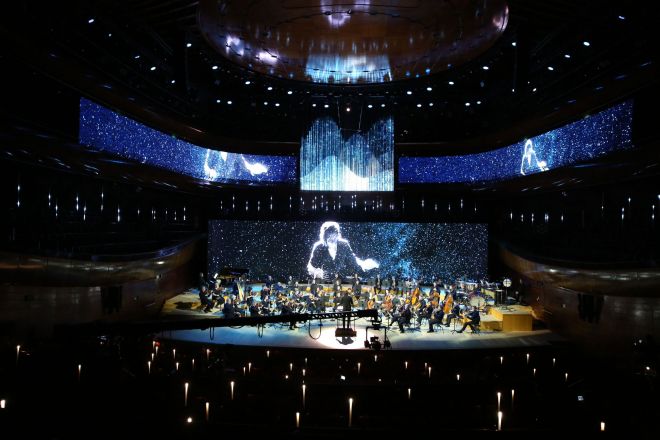
When the concert hall meets the LED display screen, the collision of tradition and modernity inspires infinite imagination.
This article will take you to explore the mystery behind this fusion, revealing how the LED display screen injects new vitality into the concert hall stage, enhances the audience experience, and maintains the artistic charm of the concert hall. Whether you are a music lover or an industry observer, you can get inspiration and gain from it.
This article will help you find out how the LED display screen brings an unprecedented viewing experience to the concert hall and its key role in improving performance effects and promoting artistic innovation.
1. The potential advantages of LED display screens in concert halls
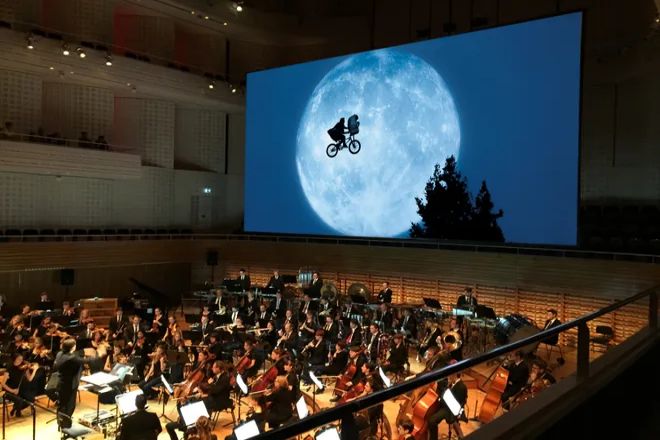
1). Enhance visual effects and deepen emotional resonance:
With its high-definition picture quality and rich color expression, the LED display screen can instantly change the stage background and create a diverse visual atmosphere for music performances.
From delicate light and shadow changes to grand scene reproduction, the LED display screen presents a visual feast for the audience, which not only enriches the layering of the stage, but also deeply conveys the emotions and artistic conception in the music works, allowing the audience to immerse themselves in the ocean of art in the dual enjoyment of hearing and vision.
2). Improve the efficiency of information transmission and optimize the viewing experience:
Before and after the concert and during the intermission, the LED display screen is transformed into an efficient information bulletin board, which timely and accurately transmits key information such as performance arrangements, artist introductions, and program previews.
This instant information transmission method not only improves the audience’s understanding and expectations of the performance but also effectively alleviates boredom during waiting and improves the overall viewing experience.
3). Promote cross-border integration and create a diverse artistic experience:
The introduction of LED display screens provides a broad stage for the cross-border integration of music and other art forms.
Through the clever combination of elements such as dance, drama, and visual arts, LED display screens can create refreshing artistic effects, break the boundaries of traditional art forms, and bring unprecedented, diverse artistic experiences to the audience.
This cross-border integration not only enriches the connotation of music performances but also promotes innovation and development in the field of art.
4). Enhance interactivity and enhance audience participation:
With the continuous development of modern technologies such as AR/VR, the interactivity of LED display screens is increasing. Through these technical means, the audience can not only watch wonderful performances but also interact with the artists on the stage and participate in the performances.
This new viewing mode greatly enhances the audience’s sense of participation and immersion, allowing every audience member to become part of the music story and jointly create unforgettable artistic memories.
2. Where the LED display screen is installed in the concert hall
In the concert hall, the installation location of the LED display screen is usually determined according to the specific layout of the concert hall, the performance requirements, and the audience’s viewing experience. Generally speaking, the LED display screen may be installed in the following locations:
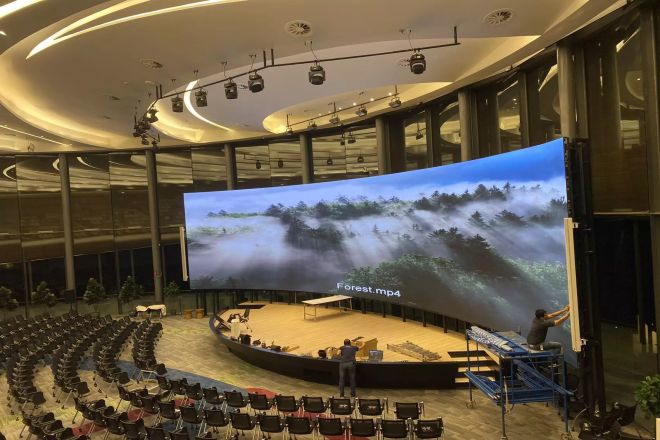
1). Stage background wall:
The stage background wall is one of the most common locations for installing LED display screens. As the stage background, the display screen can display performance-related images, videos, and other content in real-time, enhancing the visual effect of the performance and the audience’s immersion.
Considering the synchronization with the stage performance, the LED display screen on the stage background wall needs to have a high refresh rate and stability to ensure smooth and non-stuttering pictures.
2). Above or on the side of the auditorium:
Installing the LED display screen above or on the side of the auditorium can expand the display area, allowing more audiences to clearly see the content on the screen.
This installation method is particularly suitable for large concert halls or concerts with a large number of audiences. Through the multi-angle display screen arrangement, it can ensure that the audience in every corner can get a good viewing experience.
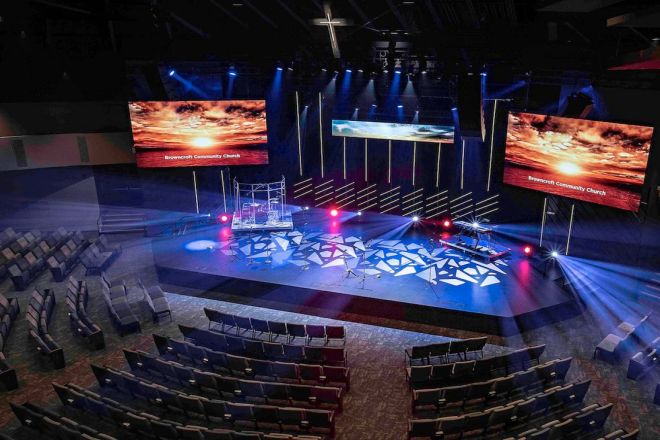
3). On both sides or diagonally in front of the stage:
Installing LED screens on both sides or diagonally in front of the stage can create a surround visual effect, allowing the audience to feel a more three-dimensional performance atmosphere.
This installation method needs to take into account factors such as the viewing angle and brightness of the display screen to ensure that the audience can get a clear visual experience at different positions.
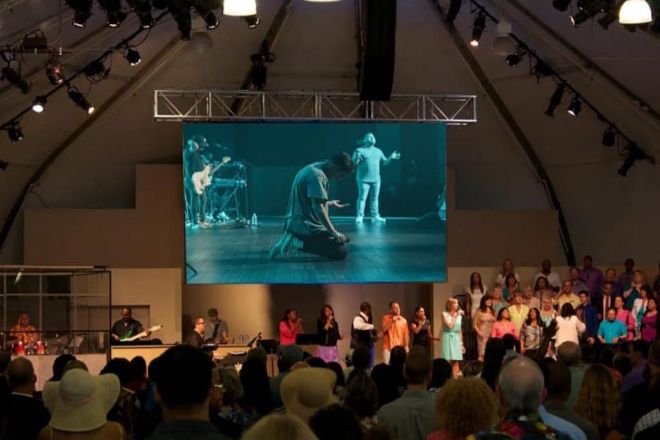
4). Specially designed hoisting structure:
For some concert halls with special design requirements, a hoisting structure may be used to install the LED display screen.
This installation method can be customized according to the specific layout of the concert hall and the performance requirements to achieve a more flexible and varied display effect.
The hoisting structure needs to ensure stability and reliability to cope with various complex environmental conditions, and the convenience of installation and disassembly must also be considered.
5). It should be noted that no matter which location is chosen to install the LED display screen, the following points need to be considered:
Display effect: Ensure that the resolution, brightness, contrast, and other parameters of the display screen can meet the performance requirements and provide the audience with a clear visual experience.
Viewing angle: According to the distribution of the auditorium, the viewing angle of the display screen is reasonably set to ensure that the audience in every corner can get a good viewing effect.
Safety: Ensure that the installation structure of the display screen is stable and reliable to prevent safety accidents such as collapse or damage during the performance.
Coordination: Ensure that the display screen is coordinated with the overall style of the concert hall to avoid abruptness or damage to the beauty of the concert hall.
3. Considerations for installing LED screens in concert halls
1). Maintaining the harmony of the original atmosphere of the concert hall:
When installing LED screens, the first Consideration is how to integrate them with the original solemn and elegant atmosphere of the concert hall.
This requires that the screen design, layout, and content display be coordinated with the overall style of the concert hall to avoid overly abrupt or commercial elements that destroy the original artistic atmosphere.
By carefully selecting the material, color, and frame design of the display screen and rationally planning its position and angle on the stage, it can be ensured that the display screen becomes an organic part of the stage, rather than a distracting presence.
2). Ensuring technical compatibility:
The compatibility of the LED screen with the existing sound and lighting systems of the concert hall is an important part of the installation process.
This requires that when selecting the display screen, factors such as the interface standard and signal transmission method be considered fully with the existing system to ensure seamless connection and achieve the harmonious unity of sound, light, and shadow.
At the same time, sufficient testing and debugging are required to ensure that during the performance, all systems can work together stably and efficiently to provide the audience with the best viewing experience.
3). Optimization of visual comfort:
In order to avoid visual fatigue or interference from the LED display screen to the audience, its brightness, color saturation, and other parameters need to be finely adjusted.
This requires scientifically setting the display parameters of the display screen according to the lighting environment of the concert hall, the distribution of the auditorium, and the needs of the performance content to ensure that the picture is clear and bright but not too glaring.
In addition, the refresh rate, contrast, and other performance indicators of the display screen need to be considered to reduce the occurrence of screen flickering, smearing, and other phenomena and improve the visual comfort of the audience.
4). Consideration of cost control and maintenance:
When installing LED display screens, cost control and maintenance issues should not be ignored.
This requires selecting cost-effective display screen products within the budget of the concert hall and rationally planning the installation plan to reduce the purchase and installation costs. At the same time, the subsequent maintenance of the display screen needs to be considered, including regular maintenance, troubleshooting, and replacement of accessories.
In order to ensure the sustainable operation of the concert hall, a detailed maintenance plan and budget plan should be formulated, and a dedicated person should be assigned to be responsible for the daily management and maintenance of the display screen.
4. Future Outlook and Suggestions
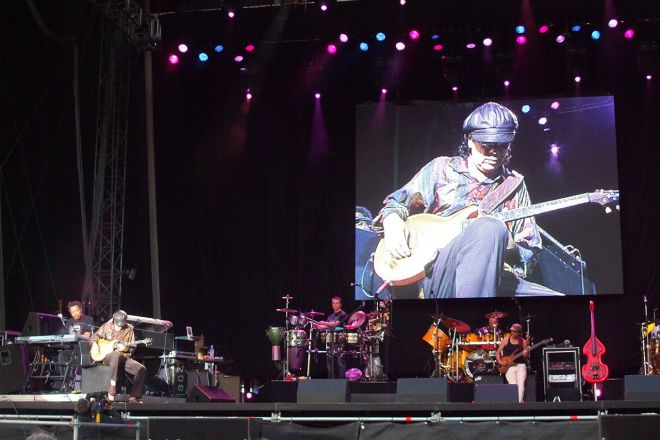
1). Technological innovation and integration
With the rapid development of science and technology, the future development trend of LED display technology in concert hall applications will pay more attention to technological innovation and integration.
We can foresee that the future LED display screen will have higher clarity to present more delicate and realistic picture effects, bringing a more shocking visual experience to the audience.
At the same time, the application of intelligent control systems will be more extensive, realizing precise control of the brightness, color, content, etc., of the display screen to meet the needs of different performance scenes.
In addition, LED display screens will also be deeply integrated with other advanced technologies, such as AR/VR and artificial intelligence, to create a richer and more diverse interactive experience, allowing the audience to immerse themselves in a fantasy world where virtuality and reality are intertwined while enjoying music.
2). Personalized customization
Given that each concert hall has its own unique architectural style and cultural heritage, the design of LED display screens in the future will pay more attention to personalized customization.
The design team should start from the material selection, color matching, shape design, and other aspects according to the specific needs and characteristics of the concert hall and create an LED display screen that is in line with the overall style of the concert hall and can show personality.
Such a design can not only enhance the artistic taste of the concert hall but also enhance the audience’s expectations and sense of identity for the performance.
3). Audience experience as the core
When introducing new technologies such as LED display screens, we should always make improving the audience experience the core goal.
This means that we need to have a deep understanding of the audience’s needs and preferences and optimize the display effect and interactive functions of the display screen from multiple dimensions, such as vision, hearing, and touch.
For example, by setting up audience interaction areas and developing exclusive APPs, the audience can participate in the performance and interact with the artists and the stage in real-time.
At the same time, we should also pay attention to the audience’s comfort issues, such as adjusting the brightness, color temperature, and other parameters of the display screen to reduce the stimulation and fatigue of the audience’s eyes.
Through the implementation of these measures, we can ensure that the application of new technologies, such as LED display screens in concert halls, can truly achieve the perfect combination of technology and art and bring a better viewing experience to the audience.
Conclusion
In short, installing LED display screens in concert halls is an attempt full of challenges and opportunities. It requires us to explore the infinite possibilities brought by new technologies while respecting the artistic atmosphere of traditional concert halls.
Through careful planning and reasonable implementation, LED displays can not only add visual shock and beauty to music performances but also promote the cross-border integration of music and other art forms and enhance the audience’s sense of participation and immersion.
Finally, if you want to know more about LED displays, please get in touch with us.
